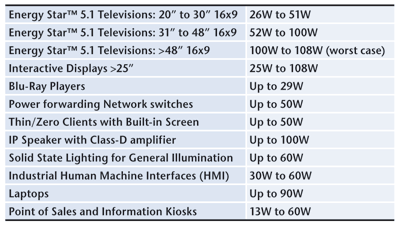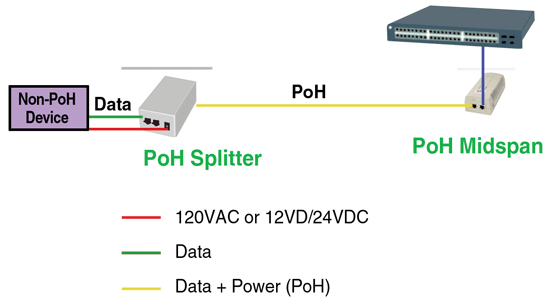PoE’s role in HDBaseT consumer digital connectivity
Power-over-HDBaseT technology will enable the RJ45 jack to be the first universal power plug
BY DANIEL FELDMAN,
Business Unit Manager, Communications Power
Microsemi
www.microsemi.com
HDBaseT technology is emerging as an important consumer electronics digital connectivity standard. Optimized for whole-home and commercial applications, HDBaseT connects entertainment devices using a 5Play feature set that converges uncompressed full HD digital video and audio plus 100BaseT Ethernet, power and various control signals onto a single 100 meter (328 foot)-long CAT5e/6 cable with RJ45 connectors. HDBaseT supports the delivery of up to 20 Gb/s of multi-stream video and audio throughput, over as many as eight, 100-meter cable hops, at double the resolution of today’s video content.
A key HDBaseT ingredient is power-over-HDBaseT (PoH) technology, which is based on the widely adopted Power-over-Ethernet (PoE) standard. PoE has already proven itself in enterprise network applications for deploying wireless access points, surveillance cameras and access control systems wherever they are needed, regardless of whether there is a nearby electrical outlet. Now, this same technology has been incorporated into the HDBaseT standard to power a wide range of consumer electronic products including big-screen TVs. This same technology also enables valuable remote management capabilities that deliver energy-saving opportunities and centralized power sourcing equipment (PSE) backup functionality during a power failure.
PoH technology delivers up to 95 W to powered devices (PDs). This is ample for the majority of consumer electronics products, including today’s typical 40-in. LED TV requiring 70-W of power, as well as new TVs governed by the 108-W restrictions of the Energy Star 5.1 standard that has been in effect since October 1, 2011 and applies to all screen sizes (see Table 1 ). Additionally, by eliminating the need for an additional power source, HDBaseT can be implemented in a single, convenient cable-connector that eliminates ac/dc and dc/dc power circuitry and enables thinner, lighter wall-mounted TVs.

Table 1: Consumer electronics devices and associated power requirements
Adapting PoE to HDBaseT apps
The HDBaseT Alliance’s September 2011 ratification of the PoH standard was an important step toward industry-wide adoption. PoH is based on the widely deployed IEEE802.3at-2009 PoE specification for delivering 30 W over two pairs of Ethernet cable over distances up to 100 meters (m). The IEEE802.3at-2009 standard also enabled the implementation of fully compliant, industry-standard PoE functionality over all four pairs of Ethernet cable. Powered devices (PDs) compliant with IEEE802.3at-2009 can already have two power interfaces and receive twice the power of earlier two-pair solutions, and PSEs can deliver 60 W of dc power over a single Ethernet cable using current levels of 600 mA rather than the 1.2-A level of two-pair 60-W midspans. PoH uses this four-pair powering capability and a higher current (almost 1 A for every two pairs) to transfer up to 100 W of continuous dc power, per port, from one side of the HDBaseT link to the other. One interesting aspect of PoH is that the power section of the standard can be used over Ethernet links, so there is no requirement for adoption of the data portions of the HDBaseT standard in order to achieve the PoH specification’s higher power benefits.
PoH is fully backward-compatible with the IEEE 802.3at-2009 specification, including Section 33.7.1 mandating that PSEs conform to IEC 60950-1:2001 and be classified as a Limited Power Source (LPS) carrying no more than 100 volt-ampere (VA) per port without requiring special overcurrent protection devices. It incorporates all necessary PD PoE compliance detection features for safe powering, as well as safe PD disconnection in overload, short circuit or under-load conditions, and enables CAT5-or-better cabling to be used for any HDBaseT installation.
PoH also complies with key UL safety requirements including UL60950-1 SELV (which caps ongoing operating voltage at 60 V a key requirement for dry areas) and UL60950-1 Inherent Limited Power Source (which caps power on a single cable at 100 W). Finally, PoH also meets National Electrical Code (NEC) requirements related to maximum voltages for non-PoE PDs and current-per-conductor restrictions for safe cabling, as well as Telecommunications Industry Association (TIA) cabling systems guidelines for temperature rise. Per TIA standards, the maximum bundle size for delivering 95 W of power is 24 cables for Cat5 cables, as compared to a maximum of 100 cables per bundle when delivering 60 W. Installations with better cabling can utilize bigger bundles (that is, 48 cables for Cat6, and 96 cables for Cat7).
Additionally, PoH goes beyond the IEEE802.3at-2009 standard to provide key improvements for HDBaseT deployment. First, it enables the implementation of a Type 2 twin PSE (which can support PoH and, with IEEE802.3at-2009, deliver up to 60 W/port), as well as a Type 3 twin PSE that can deliver up to 95 W/port. Second, it enables the use of better, shorter cable, so that it is no longer necessary to assume a worst-case cabling infrastructure – instead, PoH uses an appropriate three-event classification that enables the PD to identify the cable length, resistance and power availability, and draw more power as required, up to 100 W (See Table 2 ).

Table 2: PoH uses an appropriate three-event classification that eliminates the need to assume a worst-case cabling infrastructure
To deliver these improved powering capabilities, the latest PoE silicon has been enhanced to support PoH technology’s higher current while delivering new capabilities including dynamic power management, which cuts system costs as much as 40% by enabling the use of smaller power supplies. Today’s PSE devices also enable multiple power supplies to be used and shared between switches using backplane management techniques, and to be added incrementally, as needed, for additional power or as an emergency backup source. Finally, today’s PoE PSE manager ICs feature resilient power management, which maximizes power supply use to increase system resilience. Together, these capabilities contribute to reducing power dissipation 10% on the chip and 15% on the cable, while shrinking the system footprint by 50% or more as compared to earlier PoE solutions.
Deploying HDBaseT with PoH
In a typical PoH system, the power sourcing equipment (PSE) is installed and powered by a 50- to 57-Vdc power supply, and all PDs then receive power directly over the HDBaseT link across all four pairs of Category-5-or-better cables. It is unlikely that PoH capability will be embedded into switch equipment, as this would pose extremely difficult engineering challenges and likely reduce overall system reliability. A far more effective deployment platform is a PoH splitter and PoH midspan, which can be used with PoH-ready PDs. It is not even necessary to wait for PoH-compliant PDs. The deployment approach shown in Fig. 1 is available today.

Fig. 1: HDBaseT can be deployed using PoH-ready PDs, PoH splitters and PoH midspans.
Midspans are hubs that receive data from switches on one side, and transmit data and power on the other. In addition to providing an immediate solution for PoH deployment in the home, they also offer an ideal solution for commercial applications such as display signage, in which a 24-port PoH-midspan can be used to power 24 PoH-capable displays. They also are available in in-door-to-outdoor and outdoor-to-outdoor configurations for flexible outdoor deployment, as well. Additionally, midspans offer a variety of energy-saving power management capabilities whose benefits have been well-documented in the enterprise. For instance, IT administrators today use midspans’ management capabilities to remotely turn access points on or off at pre-determined times during low traffic periods. This can cut power consumption by as much as 70%.
PoH and interoperability
The PoH twin PSE specification, which allows the delivery of 60 W (twin Type 2) or 95 W (twin Type 3) of power, was defined so the PD can be implemented at the lowest possible cost. This is done by synchronizing the detection, classification and power on of each of the two pairs in the twin PSE. This has two consequences:
1. 2-pair PDs that are compliant with IEEE802.3af-2003 or IEEE802.3 at-2009 will always be powered over all 4 pairs when they are connected to a PoH twin PSE using standard compliant CAT5-or-better cables. This means that the power losses on the cabling will be cut by 50% for PDs consuming up to 25.5 W. This can amount to savings of over 2 W/port.
2. Four-pair PDs that are designed with a dual two-pair interface so they can be powered by asynchronous four-pair systems (such as the Cisco UPoE system) can also be powered by any PoH-compliant Type 2 or Type 3 twin PSE. This means that an investment in a PoH infrastructure will be compatible with legacy Cisco UPoE devices such as Samsung’s NC220P Cloud Station Monitor. It is important to note that the Cisco UPoE asynchronous 4-pair PSE will not necessarily be able to power Type 2 twin PoH PDs.
Energy efficiency and higher flexibility provide strong reasons to deploy PoH-compliant PSEs, even if the targeted powered application is a Cisco UPoE PD.
Universal power plug
There will be many opportunities to exploit PoH technology’s breakthrough opportunity to turn the RJ45 jack into the first universal power plug. HDBaseT deployment will benefit from PoH technology’s foundational PoE capabilities, which have been proven for the past decade in enterprise networking and IP-based security and surveillance systems to reduce installation cost and complexity while also cutting energy consumption and maintenance requirements. The HDBaseT Alliance continues to work on further enhancing PoH capabilities. In the meantime, PoH is well suited for delivering a high-performance, high-quality consumer multimedia experience at very low power-consumption rates. ■
Advertisement
Learn more about Microsemi





